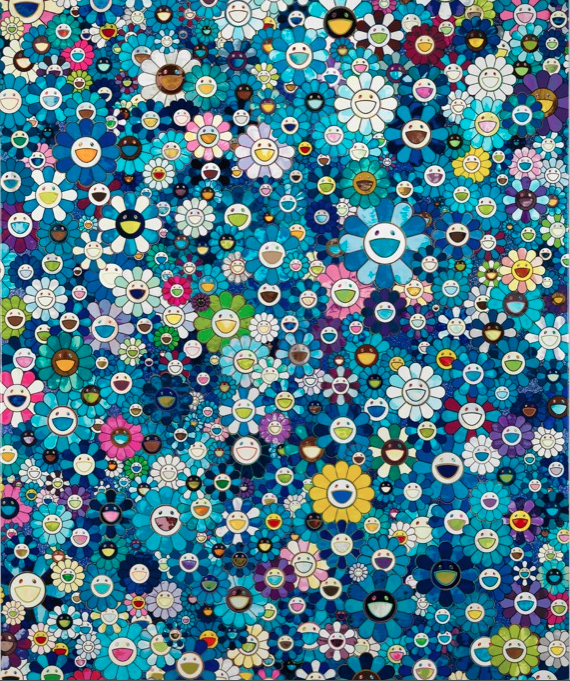TAKASHI MURAKAMI

Takashi Murakami, « What is an Artist? », un extrait de Seven Days in the Art World par Sarah Thornton
« L’artiste est un nécromancien. » Takashi Murakami profère ce jugement abstrus assis à son grand plan de travail, une table de cinq mètres de long au centre de son vaste atelier de Roppongi Hills entouré de quatre dessinateurs et cinq animateurs. Un nécromancien, qu’est-ce à dire ? Un sorcier adepte de la magie noire ? Un grand prêtre ? Un homme capable de communiquer avec les morts ? L’univers de Murakami témoigne de son long passé d’otaku fondu de science-fiction et de mangas. Le maître poursuit : « Un artiste est quelqu’un qui connaît la limite entre ce monde-ci et l’autre… Ou quelqu’un qui s’interroge sur cette frontière. » Son travail se trouve d’ailleurs à cheval sur plusieurs mondes, art et bd, yin et yang, Jekyll et Hyde, mais le créateur est tout sauf un rêveur sans but. « Je change de direction ou je garde le cap selon la réaction des gens, admet-il. Je veux survivre à long terme et rejoindre les tendances contemporaines, voilà mon premier souci. Ne travailler que pour l’argent ne correspond pas à mes valeurs. Je fonctionne par essais successifs pour être populaire. »
Je demande à cet admirateur déclaré de Warhol ce qu’il n’aime pas du grand artiste pop. Il fronce les sourcils, grogne : « J’aime tout », dit-il finalement, réponse warholienne s’il en est. « Il a eu un trait de génie, l’invention de la peinture facile. Je suis jaloux de lui. Je ne cesse de demander à mon équipe pourquoi notre travail est si compliqué alors que Warhol, lui, menait une vie facile en peinture. L’histoire le dira ! Mon point faible, c’est ma culture orientale. Les saveurs de l’Orient demandent trop de travail de présentation… Je trouve que je suis désavantagé dans l’arène de l’art contemporain mais je suis japonais, je n’ai pas le choix. »
Je cite la réplique célèbre de Warhol : « Être doué en affaires constitue la forme d’art la plus fascinante qui soit […]. Gagner de l’argent, c’est de l’art, travailler, c’est de l’art, faire de bonnes affaires, c’est le meilleur des arts. » Murakami se met à rire : « Quelle blague ! »
Takashi Murakami on « What is an Artist? » by Sarah Thornton
“An artist is a necromancer,” said Takashi Murakami, as he sat at the main workstation of his Rippongi Hills studio, a sixteen-foot-long table in the centre of a large room surrounded by four designers and five animators. The statement was cryptic. Did he mean a dark wizard? A high priest? Someone who can talk to the dead? Murakami’s work bears witness to his many years as an otaku science-fiction geek and obsessive manga fan. Murakami continued, “An artist is someone who understands the border between this world and that one… Or someone who makes an effort to know it.” Certainly Murakami’s work sits between many universes—art and cartoon, yin and yang, Jekyll and Hyde—but nowadays the artist is by no means an aimless dreamer. “I change my direction or continue in same direction by seeing people’s reaction,” he admitted. “My concentration is how to survive long-term and how to join with the contemporary feeling. To focus on nothing besides profit is, by my values, evil. But I work by trial and error to be popular.”
Murakami is an avowed Warhol fan, so I asked him what he did not like about the American pop artist. Murakami frowned and groaned. “I like everything,” he said finally, a Warholian answer if ever there was one. “Warhol’s genius was his discovery of easy painting,” he explained. “I am jealous of Warhol. I’m always asking my design team, ‘Warhol was able to create such an easy painting life, why our work so complicated?’ But the history knows! My weak point is my oriental background. Eastern flavor is too much presentation. I think it is unfair for me in the contemporary art battlefield, but I have no choice because I am Japanese.”
When I quoted Warhol’s famous line “Being good in business is the most fascinating kind of art . . . Making money is art and working is art and good business is the best art,” Murakami laughed and said, “That is a fantasy!”
Source : Galerie Perrotin
TRAVAUX/WORKS :





